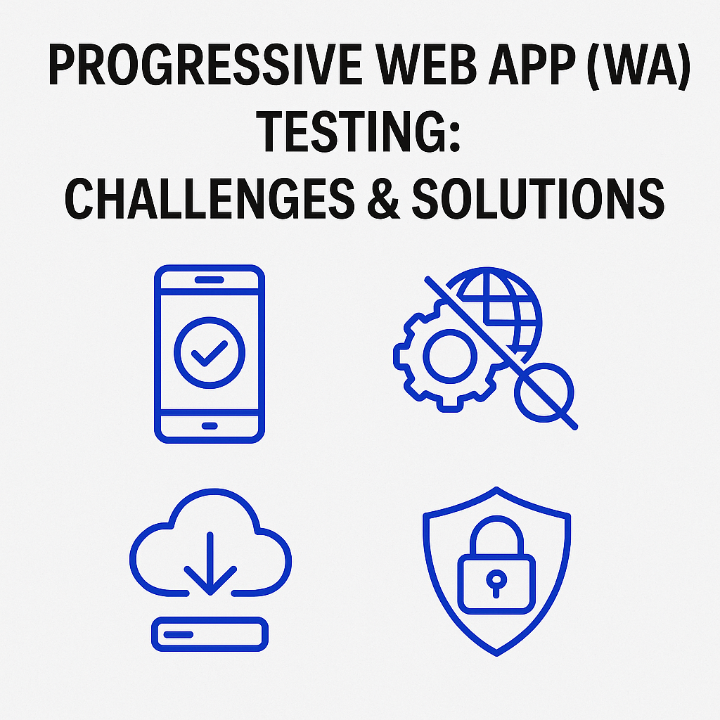 WEB TESTING
WEB TESTING Progressive Web App (PWA) Testing: Challenges & Solutions

Progressive Web Apps (PWAs) are changing the way businesses think about digital experiences. They combine the speed of mobile apps with the reach of the web, offering offline support, installability, and push notifications. That’s why companies like Twitter, Starbucks, and Pinterest have embraced them. But here’s the catch: PWAs introduce unique testing challenges that traditional web testing doesn’t fully cover. To make sure your PWA delivers a seamless, app-like experience, you’ll need a new testing approach. Let’s explore the biggest PWA testing challenges and proven solutions:
Offline Functionality
One of the biggest selling points of PWAs is offline support. Service workers are responsible for caching assets and enabling users to browse even without internet connectivity.
- Challenge: Different browsers handle caching differently. If not tested properly, users may see outdated data, broken pages, or lose functionality offline.
- Solution:
- Use Chrome DevTools to simulate offline mode and verify caching strategies.
- Audit offline behavior with Lighthouse to check for missing or broken assets.
- Create test cases that cover offline scenarios such as form submissions or reloading pages.
👉 Example: An e-commerce PWA should allow users to add items to the cart offline, then sync them once the connection is restored.
Cross-Browser Compatibility
PWAs may look perfect in Chrome but break in Safari or Firefox. Apple’s Safari, for example, has historically offered limited support for service workers and push notifications.
- Challenge: Inconsistent support across browsers and OS versions can ruin the user experience.
- Solution:
- Run cross-browser tests on BrowserStack, Sauce Labs, or Playwright.
- Maintain a compatibility matrix to track feature support across different browsers.
- Prioritize testing on Chrome (most features), Safari (limited), and Edge/Firefox.
👉 Example: A PWA that works flawlessly on Android may fail to install properly on iOS. Testing across platforms avoids nasty surprises.
Push Notifications
Push notifications are critical for engagement, but their implementation varies widely across devices and browsers.
- Challenge: Permission prompts differ between Android and iOS, and some browsers limit notifications entirely. Testing these inconsistencies is tricky.
- Solution:
- Use Firebase Test Lab to simulate push notifications on real devices.
- Test both acceptance (allow notifications) and denial flows (user blocks them).
- Validate that notifications are timely, clickable, and lead to the correct app state.
👉 Example: An airline PWA should deliver a push notification for flight delays that works consistently across Chrome on Android and Safari on iOS.
Installability & Performance
PWAs can be installed on a user’s home screen, giving them an app-like presence. But if install prompts don’t work consistently, users may never know the feature exists.
- Challenge: Installability works differently across platforms. iOS users, for instance, have to use “Add to Home Screen” manually.
- Solution:
- Test installation on both Android and iOS devices.
- Verify manifest.json and service worker configurations.
- Use Lighthouse audits to ensure the PWA meets installability criteria.
- Measure performance under different network conditions (3G, 4G, Wi-Fi).
👉 Example: Starbucks’ PWA ensures users can install the app quickly and still place orders even in low-connectivity zones.
Security
Since PWAs rely on service workers, they must be served over HTTPS to prevent man-in-the-middle attacks. Security missteps here can completely block the app.
- Challenge: A missing SSL/TLS certificate can prevent the PWA from functioning altogether.
- Solution:
- Run regular SSL/TLS checks.
- Include automated security scans (like OWASP ZAP) in your test pipeline.
- Validate that sensitive data (e.g., user credentials, payment info) is transmitted securely.
👉 Example: Payment-based PWAs like Uber Eats must enforce HTTPS and secure headers to maintain compliance.
Case Studies
- Twitter Lite: Improved session length by 65% after optimizing caching and push notifications.
- Pinterest: Saw a 44% increase in ad revenue after PWA testing ensured fast, reliable performance.
- Starbucks: Doubled daily active users with a PWA that worked smoothly even offline.
Closing Notes
PWAs have the power to bridge the web-mobile divide, but only if tested thoroughly. QA teams need to go beyond standard UI checks and focus on offline functionality, installability, performance, and security. By adopting the right tools and strategies, you can deliver PWAs that don’t just load quickly but also feel seamless across devices.